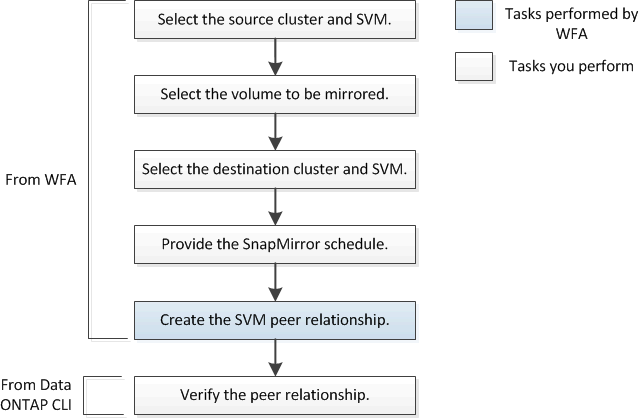
For effective data protection, the SVM Peer and SnapMirror Relationship workflow enables you to create peer relationships between storage virtual machines (SVMs, formerly known as Vservers) and set up a SnapMirror relationship for a volume in the cluster. Establishing intercluster peer relationships enables you to replicate data between different geographical locations or between SVMs on different clusters.
Establishing intercluster peer relationships enables you to replicate data between different geographical locations or between SVMs on different clusters. SnapMirror technology is a key component for enterprise data protection (DP) strategies. Establishing SnapMirror relationships enables you to mirror or replicate data over local area networks (LANs) and wide area networks (WANs).
The following sections provide details about the workflow and how to execute the workflow:
You must ensure that certain requirements are met before executing the Create SVM Peer and SnapMirror Relationship workflow. You must be a cluster administrator for executing this workflow.
The Create SVM Peer and SnapMirror Relationship workflow enables you to create peer relationships between SVMs and set up a SnapMirror relationship for a volume in the SVM. However, for setting up a Snapmirror relationship, it is not mandatory to create an SVM peer relationship.
The workflow checks for an existing SVM peer relationship and establishes the peer relationship if required.
After executing the workflow, you should periodically monitor the status of the SnapMirror relationships, including the status of the SVM peer relationship to ensure that the SnapMirror data transfers are occurring per the specified schedule. You can verify the peer relationship by running the vserver peer show command in the clustered Data ONTAP CLI.
The following illustration displays the tasks involved in executing the workflow:

The Create SVM Peer and SnapMirror Relationship workflow enables you to select the required clusters and SVMs for peering and thyen establish a Snapmirror relationship between volumes in the peered SVMs.
You should have the following input parameters available for executing the workflow:
You should verify your peer relationship by running the vserver peer show command from the Data ONTAP command-line interface (CLI). The command output displays the SVM state as peered.
You should periodically monitor the status of the SnapMirror relationships to ensure that the SnapMirror data transfers are occurring per the specified schedule.